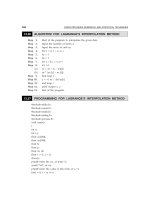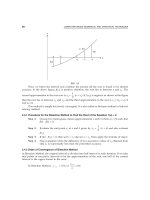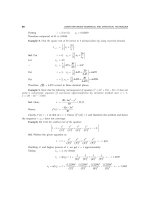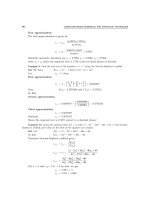Spectrum Techniques UCS30 Universal Computer
Bạn đang xem bản rút gọn của tài liệu. Xem và tải ngay bản đầy đủ của tài liệu tại đây (1.15 MB, 53 trang )
Spectrum Techniques
UCS-30
Universal Computer Spectrometer
SPECTRUM TECHNIQUES, LLC.
106 Union Valley Road
Oak Ridge, TN 37830
USA
Telephone (865) 482-9937
Fax (865) 483-0473
e-mail:
Web Site: />
Introduction ............................................................................................................................... 5
Screen View .................................................................................................................. 7
Installation................................................................................................................................. 7
Installing Software ........................................................................................................ 7
Uninstalling Software ................................................................................................... 8
Connections On Rear Panel .......................................................................................... 8
Analysis Modes........................................................................................................................10
Pulse Height Analysis (PreAmp In) .............................................................................10
Pulse Height Analysis (Amp In) ..................................................................................10
Pulse Height Analysis (Direct In) ................................................................................10
Multi Channel Scaling (Internal) .................................................................................11
External Multi Channel Scaling ...................................................................................13
Mossbauer (Internal) ....................................................................................................14
Mossbauer (External) ...................................................................................................15
Operation..................................................................................................................................16
Live Mode ....................................................................................................................16
File Mode .....................................................................................................................16
Amp/HV/ADV .............................................................................................................16
Configuring System Parameters ..............................................................................................18
High Voltage ................................................................................................................18
Amplifier Coarse Gain .................................................................................................19
Amplifier Fine Gain .....................................................................................................19
ADC Conversion Gain .................................................................................................20
Lower and Upper Level Discriminators ......................................................................20
Voltage Polarity ...........................................................................................................21
Input Polarity ...............................................................................................................21
Peak Time Shaping ......................................................................................................22
Presets ..........................................................................................................................23
Preset Time ......................................................................................................23
Preset Integral ..................................................................................................24
Go, Stop and Erase .......................................................................................................24
Regions of Interest (ROI).............................................................................................24
Functions ..................................................................................................................................25
Energy Calibration .......................................................................................................25
Temperature Compensation .........................................................................................27
Isotope Matching .........................................................................................................28
Strip Background .........................................................................................................31
Load Spectrum .................................................................................................32
Load Background .............................................................................................32
Show Spectrum ................................................................................................32
Show Background ............................................................................................32
Overlay Spectra ................................................................................................33
Strip Background from Spectrum ....................................................................33
Data Smoothing ...........................................................................................................34
Menu Bar .................................................................................................................................34
File ...............................................................................................................................34
Spectrum Techniques UCS-30
2
File Open ..........................................................................................................35
File Save...........................................................................................................35
File Load Setup ................................................................................................35
File Save Setup ................................................................................................35
File Load Library .............................................................................................35
File Save Library..............................................................................................35
File Print...........................................................................................................35
File Print Preview ............................................................................................35
File Print Setup ................................................................................................36
File Exit ............................................................................................................36
Edit ...............................................................................................................................36
Edit Experiment ...............................................................................................36
Edit Iso Match ..................................................................................................36
Edit Smooth Data .............................................................................................38
Mode ............................................................................................................................38
Display .........................................................................................................................38
Display Peak Report ........................................................................................38
Display Data Report .........................................................................................39
Display Calibration ..........................................................................................39
Display ROIs....................................................................................................39
Display Iso Match ............................................................................................39
Display Pixel Sizes ..........................................................................................39
Settings.........................................................................................................................40
Settings ROIs ...................................................................................................40
Settings Energy Calibrate ................................................................................41
Settings Preset ..................................................................................................42
Settings Amp/HV/ADC ...................................................................................42
Settings MCS ...................................................................................................42
Settings Color...................................................................................................43
Settings Confirm Spectrum Erasure.................................................................44
Settings Reset All Variables To Defaults ........................................................45
Strip Background .........................................................................................................45
Strip Background – Load Spectrum.................................................................46
Strip Background – Load Background ............................................................46
Strip Background – Show Spectrum ................................................................46
Strip Background – Show Background............................................................46
Strip Background – Overlay Spectrum ............................................................47
Strip Background – Strip Background from Spectrum ....................................47
View .............................................................................................................................48
Tool Bar ...........................................................................................................48
Status Bar .........................................................................................................48
Help ..............................................................................................................................48
Contents ...........................................................................................................48
Using Help .......................................................................................................48
About................................................................................................................48
Tool Bar ...................................................................................................................................49
Spectrum Techniques UCS-30
3
Go.................................................................................................................................49
Stop ..............................................................................................................................49
Erase .............................................................................................................................50
Show Peak Report ........................................................................................................50
Show Data Report ........................................................................................................50
Amp/HV/ADC .............................................................................................................50
Presets ..........................................................................................................................50
ROI ...............................................................................................................................50
Spectrum Window Sizing ............................................................................................50
X axis expand ...................................................................................................51
X axis contract .................................................................................................51
Specifications ...........................................................................................................................52
Hardware ......................................................................................................................52
Software .......................................................................................................................53
Spectrum Techniques Contact .................................................................................................53
Spectrum Techniques UCS-30
4
Introduction
Hardware
The Universal Computer Spectrometer offers a unique solution for nuclear spectrometry using
the PC platform. A 4K ADC (optional) combined with 8K of data memory and multi-channel
scaling is ideally suited to scintillation spectroscopy and time related studies such as half-life
decay.
Constructed in a sturdy, fully-shielded bench top enclosure with Universal Serial Bus (USB)
computer interface, the multi-channel analyzer contains many advanced features including
computer controlled amplifier and high voltage for PM tubes, upper- and lower-level
discriminators, on-instrument data memory, and a comprehensive software package for use
under Windows 2000 or higher.
The UCS-30 requires only an available USB port and is designed to work seamlessly with USBequipped PCs. For stability and low noise operation, the unit is AC-line powered with an autosensing power supply for 100-250 VAC operation. An on-board microprocessor acts as the
master controller and data storage device, as well as the communication link directly to the USB
interface.
The integrated amplifier and high voltage are fully compatible with most standard scintillation
detectors, eliminating the need for special tube bases and external modules. For ease of setup and
calibration, coarse gain, fine gain, high voltage, and lower- and upper-level discriminator settings
are controlled directly from the desktop computer. For operation with other types of detector
systems such as alpha spectrometers or single photon counting, the scintillation preamp and
amplifier can be bypassed (by computer control while in the “Mode” menu) which allows direct
access to the ADC.
A 4096 channel ADC with de-randomizing buffer offers excellent data throughput at high
counting rates with minimal dead-time losses. Conversion gain may be changed from 4096 to
either 2048, 1024, 512, or 256 channels via the software. Data from the ADC is stored directly in
on-board memory for autonomy and high-speed operation, freeing the host computer for other
tasks.
Software
The UCS-30 produces a high-resolution, real-time live color display of spectral data with
standard PC graphics running under Windows® (2000 and above). Operation is intuitive using
pull-down menus and function buttons for the most commonly used commands and display
options. The software offers full control of all features including preset live/real time and
regions-of-interest, together with centroid, gross and net area calculations.
Control of the hardware amplifier, high voltage, ADC and input discriminators is also through
function buttons for straightforward calibration and operation. To simplify identification of
Spectrum Techniques UCS-30
5
peaks, the cursor may be calibrated to read directly in energy units, using either a 2-point linear,
or 3-point quadratic relationship calibration to allow for detector non-linearity.
Spectral files may be transferred to disk for long-term storage as binary files or transferred
through the clipboard in ASCII format for exporting to other programs. Stored files may be used
to collect background data over a long counting period that can be subtracted on a time
proportional basis from the spectral data.
To aid in the identification of nuclides, the UCS-30 contains a unique peak-labeling feature
named ISOMATCH. Providing the unit is accurately energy calibrated, the user may select a
nuclide from the library and the corresponding characteristic emission lines are superimposed on
the spectrum along with isotope and energy information. Using this feature, users may quickly
check a spectrum and visually identify the emission components for each nuclide present. The
ISOMATCH libraries may be created or customized using a text editor.
When operating in multi-channel scaling mode, the system may be calibrated in time units for
direct readout from the cursor.
Both linear- and logarithmic-vertical display ranges are included, which can be useful when
performing decay studies
Spectrum files can be transferred from the ICS 10 DOS program and the ICSW 16
Windows program to the UCS-30 Windows version format.
Most functions may be accessed by more than one method. All the functions can be accessed
from the Pull Down Menues, some from the Tool Bar Buttons, or by the mouse. If the function
has a Tool Bar Button, its symbol will be shown on the left-hand side of the description.
Spectrum Techniques UCS-30
6
Screen View
Installation
System Requirements
The UCS-30 instrument uses a Universal Serial Bus (USB) to communicate with a PC. The PC
must have USB compatible drivers, which are available standard on Windows 2000 and later
releases. The performance of the USB on older systems may affect the perceived performance of
the software; so we recommend that you use a Pentium III or greater class of microprocessor
running at 550 MHz or greater to achieve desirable performance.
Installing Software
Insert the included CD in your CD-ROM drive. The install program will automatically run.
Follow the instructions to select the options you want to install.
The default installation directory is C:\Program Files\Spectrum Techniques\UCS 30
Spectrum Techniques UCS-30
7
Example files:
Spectrum (*.spu) files:
Normal.spu – contains an uncalibrated spectrum of CS-137.
Calibrated.spu – contains a calibrated spectrum of CS-137.
Setup (*.sup) files:
Normal.sup – has settings used in Normal.spu.
Calibrated.sup – has settings used in Calibrated.spu.
Library (*.itm) files
Isotopes.itm – contains a list of common isotope peaks for use with the IsoMatch
function.
Uninstalling Software
Go to the Windows Start Menu, select Settings, then Control Panel. On the Control Panel, select
Add/Remove Software. Find UCS-30, double click and follow the instructions.
Connections On Rear Panel
PREAMP POWER
AC POWER IN
90 — 240 VAC
50 — 60HZ
POS
NEG
WARN ING:
DANGEROUS VOLTAGES
ON HV CON NECTORS
MANUFACTURED BY SPEC TRUM TECHNIQUES
OAK RIDGE TENNESSEE 37830
MADE IN USA
HIGH VOLTAGE
USB
MSB
OUT
ROI
OUT
GATE
IN
MCS
IN
T/COMP
INPUT
WARNING:
DANGEROUS VOLTAGES INSIDE
SERVICE BY AUTHORIZED
PERSONNEL ONLY
Rear Panel
Spectrum Techniques UCS-30
8
CAUTION: Be sure to use the correct high voltage polarity for your device to prevent
possible damage to equipment.
POS HIGH VOLTAGE: MHV (or optional SHV) connector supplies positive 0 - 2048 volt
@ 1mA maximum current to power scintillation detectors. High voltage is fully regulated and
computer controlled in 2 volt increments.
NEG HIGH VOLTAGE: Negative High Voltage is an Option. If this option is added, the
UCS30 can also supply negative 0 - 2048 volt @ 1mA maximum current to power scintillation
detector through an MHV (or optional SHV) connector. High voltage is fully regulated and
computer controlled in 2 volt increments.
Either the POS HIGH VOLTAGE or NEG HIGH VOLTAGE may be selected for use. Go to
the “Settings” menu, then choose the “Amp/HV/ADC Settings” sub menu to gain access to the
polarity selection.
WARNING: HIGH VOLTAGE must be “OFF” before switching between POS HIGH
VOLTAGE or NEG HIGH VOLTAGE. Failure to comply with this WARNING may result in
severe instrument damage.
INPUT: BNC connector. This input is for signals from a scintillation detector, scintillation
preamplifier, or other type detector amplifiers (proportional counter, germanium detector) for
eventual processing by the ADC. The internal scintillation preamplifier and also the scintillation
amplifier can be bypassed using the “Mode” menu.
MCS IN: BNC connector to input positive Multichannel Scaling (MCS) TTL pulses, > 150nsec.
5 MHz maximum rate.
ROI OUT: (OPTIONAL) BNC connector supplies a pulse output when data is acquired in a
channel marked as a Region of Interest (ROI). The pulse width is adjustable from 100 sec to 25
msec by an internal pot. The pulse amplitude is adjustable from 0 volt to 7.5 volts by an internal
pot.
GATE IN: BNC connector for connection to external coincidence unit. A positive TTL pulse
causes the ADC to accept the next pulse. The Gate pulse must be present before the peak of the
input Pulse. Gate pulse width = 50 nsec to 2 sec.
MSB OUT: BNC connector to output the most significant MCS bit for Mossbauer Applications.
The output pulse period in seconds is equal to the dwell time multiplied by the conversion gain.
Used as a trigger for an external device (i.e. constant acceleration drive). Output will begin after
the first pass in Mossbauer mode.
T/COMP: Modular connector for connection to temperature compensated tube base.
USB: Universal Serial Bus connector for communication with computer.
PREAMP POWER: DB-9 connector, supplies 12v power for External preamplifier.
Spectrum Techniques UCS-30
9
(NOTE: An OPTIONAL 24v preamplifier power output is available to ensure compatiblity
with germanium detectors.)
Analysis Modes
Pulse Height Analysis (PreAmp In)
Similar to the 'PHA PreAmp In' operating
mode except that the incoming signal
bypasses the instrument's internal PreAmplifier.
The amplitude of each detector pulse is
measured by the ADC and stored as an
amplitude (energy) spectrum.
This is the normal operating mode for
collecting sample gamma emission spectra.
The amplitude of each detector pulse is
measured by the ADC and stored as an
amplitude (energy) spectrum.
The X axis is scaled to the selected channels
and the Y axis is scaled for the counts for each
channel. Y axis counts that exceed the
maximum Y axis value are ‘wrapped’; they no
longer are scaled to the Y axis, and they
appear in a different color.
Pulse Height Analysis (Amp In)
Pulse Height Analysis (Direct In)
Similar to the 'PHA PreAmp In' operating
mode except that the incoming signal
bypasses both the instrument's internal PreAmplifier and Amplifier.
The amplitude of each detector pulse is
measured by the ADC and stored as an
amplitude (energy) spectrum.
Spectrum Techniques UCS-30
10
Multi Channel Scaling (Internal)
(UCS20 MCS Spectrum shown; UCS30 similar)
Multi Channel Scaling mode is used for measuring time related phenomena such as half-life
decay or single photon counting. The ADC is bypassed and incoming events are routed directly
into memory for specific predetermined times (dwell time) and stored in sequential memory
locations.
To use this mode, first acquire a spectrum using the Pulse Height Analysis mode. While
acquiring the spectrum, adjust the LLD and the ULD to select the energy range of interest (for
example, selecting only the 662 keV peak from CS-137 will eliminate unwanted background and
produce a superior decay curve when using a Cs-137/Ba-137 mini-generator.)
Click the Mode menu and select MCS
Spectrum Techniques UCS-30
11
Click the Settings menu and select MCS
The Setup MCS Dwell Time dialog box will appear:
Enter the Dwell Time. This time is for each memory location (channel). Remember the total pass
time will be equal to (Conversion Gain x Dwell Time).
Erase any current memory data and click START COUNTS. The UCS-30 will proceed to count
incoming events for the selected dwell time, store the total in the first channel location, reset the
counter and repeat the cycle storing each total count in sequential channels.
Spectrum Techniques UCS-30
12
External Multi Channel Scaling
If you wish to use an external pulse generation system such as a coincidence circuit, it will be
necessary to bypass the on-board amplifier and discriminators. Connect the external counts
connector to the Ext MCS connector on the back of the instrument and select the menu item
MODE, then select External MCS.
When operating in this mode, the MCS input requires positive TTL signals (>2.5v, >150 ns
duration).
Spectrum Techniques UCS-30
13
Mossbauer (Internal)
This mode uses the internal preamp. Connect the signal into the INPUT BNC connector. The
Mossbauer mode has variable dwell time ranging from 100 Sec to 6 Sec. A Preset number of
passes can be set to the desired number or left at zero (0) for infinite passes.
The following is the Mossbauer spectrum of a Co-57 source with an enriched Fe-57 absorber,
showing nuclear Zeeman splitting.
Spectrum Techniques UCS-30
14
Mossbauer (External)
This mode requires the use of an external amplifier. The signal must connect to the MCS
INPUT BNC connector. The Mossbauer External mode has variable dwell time ranging from
100 Sec to 6 Sec. A Preset number of passes can be set to the desired number or left at zero (0)
for infinite passes.
The following is the Mossbauer spectrum of a Co-57 source with an enriched Fe-57 absorber,
showing nuclear Zeeman splitting.
Spectrum Techniques UCS-30
15
Operation
Live Mode
instrument and is used only to view and
manipulate files that have been saved to disk.
File Mode
The software starts up in the Live Mode. This
mode uses the USB to communicate with the
instrument.
If you access the File Menu and click on
Open, a new window appears which looks like
the current window, except that the title bar
shows ‘File Mode’ instead of ‘Live Mode’.
File mode does not communicate with the
File Mode is accessible from the live mode by
going to the File Menu and clicking on Open.
Select the file you want to view. Some
functions, which have no use when viewing
files, are disabled in the Menus and the
Toolbar.
Amp/HV/ADC
Click the Amp/HV/ADC Button on the
toolbar:
Or use the settings menu and click on
Amp/HV/ADC
Spectrum Techniques UCS-30
16
The Amp/HV/ADC dialog box will appear.
Adjustments may be made to the
amplification, high voltage, conversion gain,
low level discriminator, and the high level
discriminator.
Selecting OK will cause these values to be
written to the UCS-30 instrument.
Spectrum Techniques UCS-30
17
Configuring System
Parameters:
High Voltage
Once the program is running it will be
necessary to configure the system parameters
for correct operation and calibration.
Place a gamma emitting check source near the
detector face. Cesium-137 (Cs-137) is a good
choice. It has a single peak at 662 keV.
Click on Settings, then click on
Amp/HV/ADC
Set the high voltage to the voltage as listed by
the detector manufacturer. As an example, set
the high voltage to positive 600 volts; click
ON.
DO NOT exceed the maximum high voltage
rating of the detector, usually 1200 volts.
Set the amplifier COARSE GAIN to 8, and
set the FINE GAIN to 1 as a starting position.
Click on OK, to set adjustments and exit the
menu.
Start the data acquisition and adjust the
amplifier gain until the 662 keV peak is
approximately mid-scale.
Once the acquisition is started, you may enter
the Amp/HV/ADC menu and make
adjustments while viewing the spectrum. This
will allow you to position the peak in the
desired channels.
Spectrum Techniques UCS-30
High Voltage may be entered directly in the
text box or may be scrolled to the value
desired. A warning will be issued if you
attempt to input a value higher than 1200
volts, since this is the highest value that many
probes can tolerate without damage. If you
know that your probe can accept higher than
1200 volts, you may increase the voltage up to
2048 volts.
18
Amplifier Coarse Gain
Amplifier Fine Gain
Amplifier coarse gain may be set by clicking
the radio-button next to the desired multiplier.
Amplifier fine gain may be directly entered as
a multiplier value between 1.0 and 2.275 in
0.005 increments.
Spectrum Techniques UCS-30
19
ADC Conversion Gain
Lower and Upper Level Discriminators
Conversion Gain represents the number of
channels that will be sampled and displayed
on the screen. Smaller values save as smaller
files
LLD and ULD, Lower Level Discriminator,
and Upper Level Discriminator, allow the user
to set a value between 0 and 102.3 (roughly
percent) that cuts off the input signal before it
gets to the ADC. The LLD is often used to
block high-count signals (noise) in the low
range that are not of interest, but require
excessive time to sample. The ULD may be
set up to 102.3.
The conversion gain default setting is
maximum channels. This is preferred for most
scintillation detector applications and
generally no adjustment is required.
For certain applications, such as alpha
spectroscopy, it may be necessary to change
this parameter to either 256, 512, 1024, 2048
or 4096 channels.
Spectrum Techniques UCS-30
Low level discrimination (LLD) may be
scrolled or directly entered.
20
Upper level discrimination (ULD) may be
scrolled or directly entered.
The ability to switch between positive and
negative high voltage polarities is an add-on
option.
An alternative method to change the LLD and
ULD is to use the mouse to move the triangles
under the X axis. Move the mouse over the
triangle to be moved, press the left button,
drag the triangle and release it where desired.
The software will not allow the LLD and the
ULD to be set outside appropriate ranges.
Input Polarity
Voltage Polarity
Some detectors require a positive input
polarity. This option is only available in PHA
Amp In mode.
Spectrum Techniques UCS-30
21
Peak Time Shaping
Amplifier Peaking Times of 1, 2, 4, or 8
microseconds are selectable in Amp In mode
only.
Peaking times longer than 1 microsecond are
useful with solid state detectors such as Ge(Li)
or HPGE detectors.
Spectrum Techniques UCS-30
22
Presets
Preset Time
Preset Time
The real time count and the live time count
may be changed using the Preset function.
Click the Preset Time Button on the toolbar:
Preset Integral
The instrument can be set to stop
automatically after a ROI integral.
Click the Preset Integral Button on the toolbar:
Or use the settings menu and click on Presets:
Preset Live Time provides automatic
correction for counting losses caused by the
system deadtime, or the amount of time
required by the system to process pulses.
Events which occur during the pulse
processing cycle are lost to the system so the
timer is automatically updated to compensate
for these losses. When operating at
excessively high count-rates the deadtime
meter will indicate a high value and the real
counting time may be more than doubled.
Increasing the LLD setting can help reduce
some high deadtime effects.
Preset Real Time sets the counting timer to
run for actual clocktime and makes no
correction for losses due to deadtime effects.
Click on Settings, click on Presets
Enter the LIVE or REAL time in the correct
box. Click on OK, to set adjustment and exit
menu.
Both the LIVE TIME and REAL TIME values are displayed on the UCS-30 status bar as LT
and RT. These values are saved in the file during data storage.
Spectrum Techniques UCS-30
23
Preset Integral
Set Integral
To set an integral count it is necessary to
first establish a ROI and then position the
marker within the region.
Selecting an ROI and setting a value other
than 0 in preset integral will cause the
system to STOP counting when the total
counts of all the channels within the ROI
reaches that value.
Go, Stop and Erase
Go, Stop and Erase functions are accessed
with the Tool Bar buttons. Clicking on Start
begins data collection. Clicking on Stop ends
data collection. Clicking on Erase sets each
channel’s data to zero. Additionally, three 'hot
key' combination are defined as shortcuts for
data acquisition functions. Pressing the
appropriate action key while pressing the 'Ctrl'
and 'Shift' keys will provide Go, Stop and
Erase action. To Go press 'Ctrl+Shift+A'; to
Stop press 'Ctrl+Shift+S'; and to Erase press
'Ctrl+Shift+E'.
Region of Interest (ROI)
Region of interest (ROI) selection is an
advanced feature which provides
instantaneous computation of peak gross and
net counts. These values may be used along
with isotope decay tables and detection
efficiency to calculate absolute or relative
isotopic activities. ROIs must not overlap and
need to be separated by at least one channel
for correct area calculation. Up to 16 different
ROIs are possible using the color selector
from the pull down Settings menu.
Spectrum Techniques UCS-30
24
Set ROI
To set an ROI around a peak, click the ROI
button on the Tool Bar. Click the left mouse
button at the beginning of the ROI, hold down
the left mouse button and drag the marker to
the other side of the peak, release mouse
button.
Clear ROI
Move marker to the ROI to be cleared. Open
the Setting Menu, open ROI and select Clear
ROI.
Gross and Net Count
When the marker is positioned in a region of
interest (ROI), the UCS-30 software
automatically calculates the Gross and Net
area of the region. In order to minimize
statistical effects at the ROI endpoints, a 3point averaging technique is applied. The
contents of channels (n-1), (n), and (n+1) are
summed and averaged to derive the content of
the endpoint channel for the net area
computation. A linear interpolation is
performed between these averaged endpoint
values and counts below this interpolation are
subtracted to arrive at the Net area of the
peak. Gross counts is the sum of all channels
in the ROI.
Position the marker in the peak of interest.
The Gross and Net areas are automatically
computed and displayed on the spectrum
screen.
Functions
Energy Calibration
In order to perform an energy calibration, it
is first necessary to acquire a spectrum using
known isotopes. Cs-137 together with Co-60
works well for many applications, producing
gamma lines at 32 keV, 662 keV, 1173 keV
and 1332 keV.
The energy calibration feature allows the
marker to read directly in energy units. Two
calibration functions are possible, a 2-point
linear, or a 3-point quadratic fit.
Spectrum Techniques UCS-30
Select 2-point or 3-point mode and enter
the calibration units to be used, (keV or
MeV). Position the marker at the highest
channel of the first peak and enter the peak
energy value. Move the marker to the high
point on the second peak to be used for the
calibration, enter energy number. If a 3point calibration is required, continue by
moving the marker to the peak channel of
the third peak, enter its energy and click OK.
The system will now be calibrated and the
marker position will read directly in energy.
To return to the channel number mode, click
on Settings, click on Uncalibrate.
25









